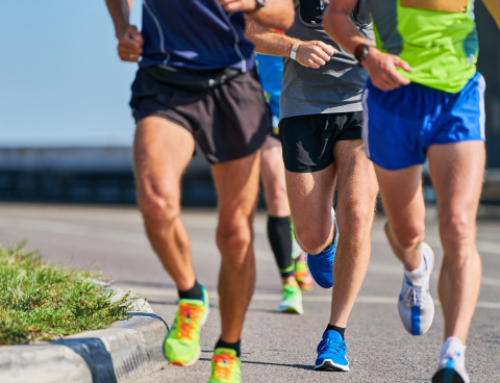How Olympic Decathlete Bryan Clay Pulls Away Near the Finish Line
Elite ASICS athlete Bryan Clay makes “fast” look easy. Of course he does. Once named “The World’s Greatest Athlete” for winning an Olympic Gold Medal in the decathlon, Clay blows by competitors with his “warm-up strides.” Then, after about 20 meters, he turns on the afterburners and sprints out of sight.
Clay trains at Azusa Pacific University, which he attended a decade ago. The drills he is doing today are called Frequency Runs. He gradually accelerates for the first 20 to 30 meters, then performs an all-out sprint for the next 30. But here’s the thing: he must maintain perfect form in the all-out portion, which forces him to focus on running explosively with quick foot turnover. He says, “You’re trying to run wide open—as fast as you can—while getting in as many steps as you can. So you have to keep the stride length tight.”
Clay’s workout hones his mechanics and helps him maintain top-end speed so he can press the pedal to the metal in the latter stages of events. Toward the end of most races, the winner is the athlete who can hold his speed, or, more precisely, who decelerates the least. When you see a sprinter pull away from the pack, he’s not necessarily blowing by them, he’s just not slowing down as much as they are.
Incorporate Frequency Runs into your training once per week. Do them before you lift so you can work on top speed when you’re fresh. That’s the approach Clay uses, performing his sprint work before he moves on to field drills like Pole Vault, Discus and Javelin, so he can stay strong even if he’s tired.
“A lot of guys like to vault on fresh legs. I like to vault on tired legs, because in the decathlon the vault is on the second day of competition, the seventh event,” Clay says. “I try to mimic on the track what I will feel when I’m competing.”
That’s good training advice for any athlete.
Bryan Clay’s Max Velocity Workout

Speed Work: Perform 6 to 10 50- to 60-meter Frequency Runs, building up speed during the first 20 to 30 meters, then sprinting all out with perfect form for the last 30 meters. Allow for full recovery after each run.
Lifting: After his sprints, Clay moves on to the Javelin, Shot Put and High Jump. If you’re not a decathlete, hit the gym and do your regular lifting. You’ll have plenty of pop after performing Clay’s sprint routine.
RECOMMENDED FOR YOU
How Olympic Decathlete Bryan Clay Pulls Away Near the Finish Line
Elite ASICS athlete Bryan Clay makes “fast” look easy. Of course he does. Once named “The World’s Greatest Athlete” for winning an Olympic Gold Medal in the decathlon, Clay blows by competitors with his “warm-up strides.” Then, after about 20 meters, he turns on the afterburners and sprints out of sight.
Clay trains at Azusa Pacific University, which he attended a decade ago. The drills he is doing today are called Frequency Runs. He gradually accelerates for the first 20 to 30 meters, then performs an all-out sprint for the next 30. But here’s the thing: he must maintain perfect form in the all-out portion, which forces him to focus on running explosively with quick foot turnover. He says, “You’re trying to run wide open—as fast as you can—while getting in as many steps as you can. So you have to keep the stride length tight.”
Clay’s workout hones his mechanics and helps him maintain top-end speed so he can press the pedal to the metal in the latter stages of events. Toward the end of most races, the winner is the athlete who can hold his speed, or, more precisely, who decelerates the least. When you see a sprinter pull away from the pack, he’s not necessarily blowing by them, he’s just not slowing down as much as they are.
Incorporate Frequency Runs into your training once per week. Do them before you lift so you can work on top speed when you’re fresh. That’s the approach Clay uses, performing his sprint work before he moves on to field drills like Pole Vault, Discus and Javelin, so he can stay strong even if he’s tired.
“A lot of guys like to vault on fresh legs. I like to vault on tired legs, because in the decathlon the vault is on the second day of competition, the seventh event,” Clay says. “I try to mimic on the track what I will feel when I’m competing.”
That’s good training advice for any athlete.
Bryan Clay’s Max Velocity Workout

Speed Work: Perform 6 to 10 50- to 60-meter Frequency Runs, building up speed during the first 20 to 30 meters, then sprinting all out with perfect form for the last 30 meters. Allow for full recovery after each run.
Lifting: After his sprints, Clay moves on to the Javelin, Shot Put and High Jump. If you’re not a decathlete, hit the gym and do your regular lifting. You’ll have plenty of pop after performing Clay’s sprint routine.











